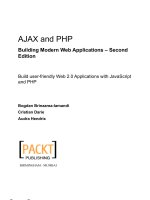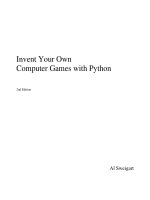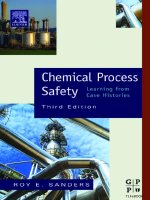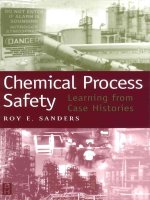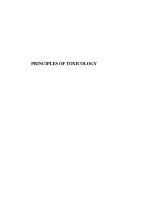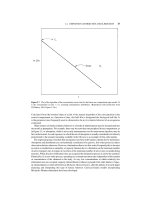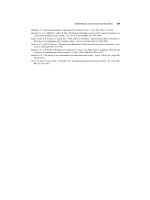chemical process safety fundamentals with applications (2nd edition)
Bạn đang xem bản rút gọn của tài liệu. Xem và tải ngay bản đầy đủ của tài liệu tại đây (9.83 MB, 650 trang )
Daniel
A.
Crowl/Joseph
F.
Lowar
a
Amam-
11-111-1-1
C
'-
Process
I
5econd Edition
Prentice
Hall
International Series
in
the
Physical
and
Chemlcal
Engineering Sciences
I
Chemical Process Safety
ISBN
0-13-OZ817b-5
9
780130
181763
PRENTICE HALL INTERNATIONAL SERIES
IN THE PHYSICAL AND CHEMICAL ENGINEERING SCIENCES
NEAL
R.
AMUNDSON, SERIES EDITOR,
University of Houston
ANDREAS ACRIVOS,
Stanford University
JOHN DAHLER,
University of Minnesota
H.
SCOTT FOGLER,
University of Michigan
THOMAS J. HANRATTY,
University of Illinois
JOHN
M.
PRAUSNITZ,
University of California
L.
E.
SCRIVEN,
University of Minnesota
BALZHISER, SAMUELS,
AND
ELIASSEN
Chemical Engineering Thermodynamics
BEQUETTE
Process Control: Modeling, Design and Simulation
BEQUETTE
Process Dynamics
BIEGLER, GROSSMAN,
AND
WESTERBERG
Systematic Methods of Chemical Process
Design
BROSILOW
AND
JOSEPH
Techniques of Model-Based Control
CROWL
AND
LOUVAR
Chemical Process Safety: Fundamentals with Applications,
2nd edition
CONSTANTINIDES
AND
MOSTOUFI
Numerical Methods for Chemical Engineers
with
MATLAB Applications
CUTLIP
AND
SHACHAM
Problem Solving in Chemical Engineering with Numerical
Methods
DENN
Process Fluid Mechanics
DOYLE
Process Control Modules: A Software Laboratory for Control Design
ELLIOT
AND
LIRA
Introductory Chemical Engineering Thermodynamics
FOGLER
Elements of Chemical Reaction Engineering, 3rd edition
HIMMELBLAU
Basic Principles and Calculations in Chemical Engineering, 6th edition
HINES
AND
MADDOX
Mass Transfer
KYLE
Chemical and Process Thermodynamics, 3rd edition
PRAUSNITZ, LICHTENTHALER,
AND DE
AZEVEDO
Molecular Thermodynamics
of Fluid-Phase Equilibria, 3rd edition
PRENTICE
Electrochemical Engineering Principles
SHULER
AND
KARGI
Bioprocess Engineering, 2nd edition
STEPHANOPOULOS
Chemical Process Control
TESTER
AND
MODELL
Thennodynainics and Its Applications, 3rd edition
TURTON, BAILIE, WHITING,
AND
SHAEIWITZ
Analysis, Synthesis and Design
of Chemical Processes
WILKES
Fluid Mechanics for Chemical Engineering
Prentice Hall International Series in the Physical and Chemical Engineering Sciences
Chemical Process Safety
Fundamentals with Applications
Second Edition
Daniel
A.
Crow1
Michigan Technological University
Joseph
F.
Louvar
Wayne State University
Prentice Hall PTR
Upper Saddle River, New Jersey
07458
www.phptr.com
Library of Congress Cataloging-in-Publication data
Crowl, Daniel A.
Chemical process safety
:
fundamentals with applications I Daniel A. Crowl, Joseph
F.
Louvar.
-
2nd ed.
p. cm.
-
(Prentice Hall international series in the physical and chemical engineering sciences)
Includes bibliographical references and index.
ISBN 0-13-018176-5
1. Chemical plants -Safety measures. I. Louvar, Joseph
F.
11. Title. 111. Series.
EditoriallProduction Supervision:
G&S Typesetters, Inc.
Acquisitions Editor:
Bernard Goodwin
Marketing Manager:
Dan DePasquale
Cover Design Direction:
Jerry Votta
Art Director:
Gail Cocker-Bogusz
Manufacturing Manager:
Alexis
R.
Heydt-Long
Editorial Assistant:
Michelle Vincenti
Project Coordinator:
Anne
R.
Garcia
O
2002 by Prentice Hall PTR
Prentice Hall, Inc.
Upper Saddle River, NJ 07458
Prentice Hall books are widely used by corporations and government agencies for training, marketing, and
resale.
The publisher offers discounts on this book when ordered in bulk quantities.
For more information, contact Corporate Sales Department, phone: 800-382-3419;
fax: 201-236-7141;
email:
Or write: Prentice Hall PTR
Corporate Sales Department
One Lake Street
Upper Saddle River, NJ 07458
All rights reserved. No part of this book may be reproduced, in any form or by any means, without permission
in writing from the publisher.
Printed in the United States of America
10987654321
ISBN: 0-13-018176-5
Pearson Education Ltd.
Pearson Education Australia PTY, Ltd.
Pearson Education Singapore, Pte. Ltd.
Pearson Education North Asia Ltd.
Pearson Education Canada, Ltd.
Pearson Educaci6n de Mexico, S.A. de
C.V.
Pearson Education
-
Japan
Pearson Education Malaysia, Pte. Ltd.
Pearson Education, Upper Saddle
New Jersey
Contents
Preface
xiii
Nomenclature
xv
1
Introduction
1
Safety Programs 2
Engineering Ethics 4
Accident and Loss Statistics 4
Acceptable Risk 12
Public Perceptions 14
The Nature of the Accident Process
15
Inherent Safety 20
Four Significant Disasters 23
Flixborough, England 23
Bhopal, India
25
Seveso, Italy 26
Pasadena, Texas 27
Suggested Reading 29
Problems 30
2
Toxicology
35
2-1 How Toxicants Enter Biological Organisms 36
Gastrointestinal Tract 37
Skin 37
Respiratory System 38
2-2 How Toxicants Are Eliminated from Biological Organisms 39
2-3 Effects of Toxicants on Biological Organisms 40
2-4 Toxicological Studies 41
2-5 Dose versus Response 42
vi
Contents
2-6 Models for Dose and Response Curves 48
2-7 Relative Toxicity 54
2-8 Threshold Limit Values 54
Suggested Reading 59
Problems 59
3 Industrial Hygiene
63
3-1 Government Regulations 64
Laws and Regulations 64
Creating a Law 64
Creating a Regulation 64
OSHA: Process Safety Management 68
EPA: Risk Management Plan 71
3-2 Industrial Hygiene: Identification 74
Material Safety Data Sheets 74
3-3 Industrial Hygiene: Evaluation 78
Evaluating Exposures to Volatile Toxicants by Monitoring 79
Evaluation of Worker Exposures to Dusts
83
Evaluating Worker Exposures to Noise
84
Estimating Worker Exposures to Toxic Vapors
85
3-4 Industrial Hygiene: Control 94
Respirators 96
Ventilation 97
Suggested Reading 103
Problems 104
Source Models
109
4-1 Introduction to Source Models 109
4-2 Flow of Liquid through a Hole 112
4-3
Flow of Liquid through a Hole in
a
Tank 116
4-4 Flow of Liquids through Pipes 121
2-K Method 124
4-5
Flow of Vapor through Holes 130
4-6 Flow of Gases through Pipes 136
Adiabatic Flows 136
Isothermal Flows 143
4-7 Flashing Liquids 151
4-8 Liquid Pool Evaporation or Boiling 157
4-9 Realistic and Worst-Case Releases 159
4-10 Conservative Analysis 159
Suggested Reading 161
Problems 162
Contents
vii
5
Toxic Release and Dispersion Models
171
5-1 Parameters Affecting Dispersion 172
5-2 Neutrally Buoyant Dispersion Models 176
Case
1:
Steady-State Continuous Point Release with No Wind
180
Case 2: Puff with No Wind
181
Case 3: Non-Steady-State Continuous Point Release with No Wind
182
Case 4: Steady-State Continuous Point Source Release with Wind 183
Case 5: Puff with No Wind and Eddy Diffusivity Is a Function of Direction
183
Case 6: Steady-State Continuous Point Source Release with Wind and Eddy
Diffusivity
Is
a Function of Direction
184
Case
7:
Puff with Wind 184
Case 8: Puff with No Wind and with Source on Ground
185
Case 9: Steady-State Plume with Source on Ground
185
Case 10: Continuous Steady-State Source with Source at Height
Hr
above
the Ground 186
Pasquill-Gifford Model 186
Case 11: Puff with Instantaneous Point Source at Ground Level, Coordi-
nates Fixed at Release Point, Constant Wind Only in
x
Direction with
Constant Velocity
u
190
Case 12: Plume with Continuous Steady-State Source at Ground Level and
Wind Moving in
x
Direction at Constant Velocity
u
191
Case 13: Plume with Continuous Steady-State Source at Height
Hr
above
Ground Level and Wind Moving in
x
Direction at Constant Velocity
u
192
Case 14: Puff with Instantaneous Point Source at Height
Hr
above Ground
Level and a Coordinate System on the Ground That Moves with the Puff
193
Case 15: Puff with Instantaneous Point Source at Height
Hr
above Ground
Level and a Coordinate System Fixed on the Ground at the Release
Point 194
Worst-Case Conditions 194
Limitations to Pasquill-Gifford Dispersion Modeling
194
5-3 Dense Gas Dispersion 195
5-4 Toxic Effect Criteria 199
5-5 Effect of Release Momentum and Buoyancy 212
5-6 Release Mitigation 213
Suggested Reading 214
Problems 215
6
Fires and Explosions
225
6-1 The Fire Triangle 225
6-2 Distinction between Fires and Explosions 227
-
-
-
-
-
viii
Contents
6-3 Definitions 227
6-4 Flammability Characteristics of Liquids and Vapors 229
Liquids 230
Gases and Vapors 233
Vapor Mixtures 233
Flammability Limit Dependence on Temperature
235
Flammability Limit Dependence on Pressure 236
Estimating Flammability Limits 236
6-5 Limiting Oxygen Concentration and Inerting 238
6-6 Flammability Diagram 240
6-7 Ignition Energy 248
6-8 Autoignition 249
6-9 Auto-Oxidation 249
6-10 Adiabatic Compression 249
6-11
Ignition Sources 251
6-12 Sprays and Mists 252
6-13 Explosions 252
Detonation and Deflagration 253
Confined Explosions 255
Blast Damage Resulting from Overpressure 265
TNT Equivalency 269
TNO Multi-Energy Method 271
Energy of Chemical Explosions 274
Energy of Mechanical Explosions 276
Missile Damage 279
Blast Damage to People 279
Vapor Cloud Explosions 281
Boiling-Liquid Expanding-Vapor Explosions 282
Suggested Reading 282
Problems 283
7
Designs to Prevent Fires and Explosions
291
7-1 Inerting 292
Vacuum Purging 292
Pressure Purging 295
Combined Pressure-Vacuum Purging 297
Vacuum and Pressure Purging with Impure Nitrogen
298
Advantages and Disadvantages of the Various Pressure and Vacuum
Tnert-
ing Procedures 299
Sweep-Through Purging 299
Siphon Purging 301
Using the Flammability Diagram To Avoid Flammable Atmospheres 301
7-2 Static Electricity 307
Fundamentals of Static Charge
307
Contents
ix
Charge Accumulation 308
Electrostatic Discharges 309
Energy from Electrostatic Discharges 311
Energy of Electrostatic Ignition Sources
312
Streaming Current 313
Electrostatic Voltage Drops 316
Energy of Charged Capacitors 316
Capacitance of a Body 321
Balance of Charges 324
7-3 Controlling Static Electricity 330
General Design Methods To Prevent Electrostatic Ignitions 333
Relaxation 332
Bonding and Grounding 332
Dip Pipes 333
Increasing Conductivity with Additives 336
Handling Solids without Flammable Vapors
337
Handling Solids with Flammable Vapors
337
7-4 Explosion-Proof Equipment and Instruments 337
Explosion-Proof Housings 339
Area and Material Classification 339
Design of an XP Area 340
7-5 Ventilation 340
Open-Air Plants 340
Plants Inside Buildings 341
7-6 Sprinkler Systems 343
7-7 Miscellaneous Designs for Preventing Fires and Explosions 347
Suggested Reading 347
Problems 348
8
Introduction to Reliefs
353
8-1 Relief Concepts 354
8-2 Definitions 356
8-3 Location of Reliefs 357
8-4 Relief Types 360
8-5 Relief Scenarios 364
8-6 Data for Sizing Reliefs 365
8-7 Relief Systems 368
Relief Installation Practices 368
Relief Design Considerations 368
Horizontal Knockout Drum 371
Flares 375
Scrubbers 376
Condensers 376
Suggested Reading 376
Problems 377
x
Contents
9 Relief Sizing
383
9-1 Conventional Spring-Operated Reliefs in Liquid Service 384
9-2 Conventional Spring-Operated Reliefs in Vapor or Gas Service 389
9-3 Rupture Disc Reliefs in Liquid Service 394
9-4 Rupture Disc Reliefs in Vapor or Gas Service 394
9-5 Two-Phase Flow during Runaway Reaction Relief 395
Simplified Nomograph Method 401
9-6 Deflagration Venting for Dust and Vapor Explosions 404
Vents for Low-Pressure Structures 406
Vents for High-Pressure Structures 408
9-7 Venting for Fires External to Process Vessels 411
9-8 Reliefs for Thermal Expansion of Process Fluids 415
Suggested Reading 418
Problems 420
10 Hazards Identification 429
10-1 Process Hazards Checklists 432
10-2 Hazards Surveys 432
10-3 Hazards and Operability Studies 448
10-4 Safety Reviews 454
10-5 Other Methods 459
Suggested Reading 460
Problems 460
11
Risk Assessment 471
11-1 Review of Probability Theory 472
Interactions between Process Units 474
Revealed and Unrevealed Failures 480
Probability
of
Coincidence 484
Redundancy 486
Common Mode Failures 486
11-2 Event Trees 486
11-3 Fault Trees 491
Determining the Minimal Cut Sets 494
Quantitative Calculations Using the Fault Tree 497
Advantages and Disadvantages of Fault Trees 498
Relationship between Fault Trees and Event Trees
498
11-4 QRA and
LOPA 499
Quantitative Risk Analysis 499
Layer of Protection Analysis 500
Consequence 503
Frequency 503
Suggested Reading 507
Problems 508
Contents
xi
Accident Investigations 515
12-1 Learning from Accidents 515
12-2 Layered Investigations 516
12-3 Investigation Process 518
12-4 Investigation Summary 519
12-5 Aids for Diagnosis 521
Fires 522
Explosions 522
Sources of Ignition in Vessels 523
Pressure Effects 523
Medical Evidence 525
Miscellaneous Aids to Diagnosis 525
12-6 Aids for Recommendations 528
Control Plant Modifications 528
User-Friendly Designs 529
Block Valves 529
Double Block and Bleed 530
Preventive Maintenance 530
Analyzers 531
Suggested Reading 532
Problems 532
13 Case Histories 535
13-1 Static Electricity 536
Tank Car Loading Explosion 536
Explosion in a Centrifuge 536
Duct System Explosion 537
Conductor in a Solids Storage Bin 537
Pigment and Filter 536
Pipefitter's Helper 536
Lessons Learned 536
13-2 Chemical Reactivity 540
Bottle of Isopropyl Ether 540
Nitrobenzene Sulfonic Acid Decomposition 540
Organic Oxidation 541
Lessons Learned 541
13-3 System Designs 546
Ethylene Oxide Explosion 546
Ethylene Explosion 546
Butadiene Explosion 546
Light Hydrocarbon Explosion 547
Pump Vibration 547
Pump Failure 547
Ethylene Explosion (1) 548
xii
Contents
Ethylene Explosion (2) 548
Ethylene Oxide Explosion 548
Lessons Learned 549
13-4 Procedures 551
Leak Testing a Vessel 552
Man Working in Vessel 552
Vinyl Chloride Explosion 552
Dangerous Water Expansion 553
Phenol-Formaldehyde Runaway Reaction 553
Conditions and Secondary Reaction Cause Explosion 554
Fuel-Blending Tank Explosion 555
Lessons Learned 556
13-5 Conclusion 556
Suggested Reading 557
Problems 557
Appendix
A:
Unit Conversion Constants 561
Appendix
B:
Flammability Data for Selected Hydrocarbons 565
Appendix C: Detailed Equations for Flammability Diagrams 571
Equations Useful for Placing Vessels into and out of Service 576
Appendix D: Formal Safety Review Report for Example
10-4
581
Appendix E: Saturation Vapor Pressure Data 591
Preface
T
his second edition of
Chemical Process Safety
is de-
signed to enhance the process of teaching and applying the fundamentals of chemical process
safety. It is appropriate for an industrial reference, a senior-level undergraduate course, or a
graduate course in chemical process safety. It can be used by anyone interested in improving
chemical process safety, including chemical and mechanical engineers and chemists. More ma-
terial is presented than can be accommodated in a 3-credit course, providing instructors with
the opportunity to emphasize their topics of interest.
The primary objective of this textbook is to encapsulate the important technical funda-
mentals of chemical process safety. The emphasis on the fundamentals will help the student
and practicing scientist to
understand
the concepts and apply them accordingly. This applica-
tion requires a significant quantity of fundamental knowledge and technology.
The second edition has been rewritten to include new process safety technology and new
references that have appeared since the first edition was published in 1990. It also includes our
combined experiences of teaching process safety in both industry and academia during the past
10 years.
Significant modifications were made to the following topics: dispersion modeling, source
modeling, flammability characterization, explosion venting, fundamentals of electrostatics, and
case histories. This new edition also includes selected materials from the latest AICHE Center
for Chemical Process Safety (CCPS) books and is now an excellent introduction to the CCPS
library.
This second edition also includes more problems (now 30 per chapter). A complete set of
problem solutions is available to instructors using the book in their curriculum. These changes
fulfill the requests of many professors who have used this textbook.
We continue to believe that a textbook on safety is possible only with both industrial and
academic inputs. The industrial input ensures that the material is industrially relevant. The
xiv
Preface
academic input ensures that the material is presented on a fundamental basis to help professors
and students understand the concepts. Although the authors are (now) both from universities,
one has over
30
years of relevant experience in industry
(J.
F.
L.)
and the other
(D.
A.
C.)
has
accumulated significant industrial experience since the writing of the first edition.
Since the first edition was published, many universities have developed courses or course
content in chemical process safety. This new emphasis on process safety is the result of the pos-
itive influences from industry and the Accreditation Board for Engineering and Technology
(ABET). Based on faculty feedback, this textbook is an excellent application of the funda-
mental topics that are taught in the first three years of the undergraduate education.
Although professors normally have little background in chemical process safety, they
have found that the concepts in this text and the accompanying problems and solutions are easy
to learn and teach. Professors have also found that industrial employees are enthusiastic and
willing to give specific lectures on safety to enhance their courses.
This textbook is designed for a dedicated course in chemical process safety. However, we
continue to believe that chemical process safety should be part of every undergraduate and
graduate course in chemistry and chemical and mechanical engineering, just as it is a part of all
the industrial experiences. This text is an excellent reference for these courses. This textbook
can also be used as a reference for a design course.
Some will remark that our presentation is not complete or that some details are missing.
The purpose of this book, however, is not to be complete but to provide a starting point for
those who wish to learn about this important area. This book, for example, has a companion text
titled
Health and Environmental Risk Analysis
that extends the topics relevant to risk analysis.
We thank many of our friends who continue to teach us the fundamentals of chemical
process safety. Those who have been especially helpful include G. Boicourt and
J.
Wehman of
the BASF Corporation; W. Howard and S.
Grossel, who have extensive industrial experience
and are now consultants;
B.
Powers from Dow Chemical Company; D. Hendershot from Rohm
and
Haas;
R.
Welker of the University of Arkansas;
R.
Willey of Northeastern University; and
R.
Darby of Texas A&M University.
We also continue to acknowledge and thank all the members of the Undergraduate Ed-
ucation Committee of the Center for Chemical Process Safety and the Safety and Loss Pre-
vention Committee of the American Institute of Chemical Engineers. We are honored to be
members of both committees. The members of these committees are the experts in safety; their
enthusiasm and knowledge have been truly educational and a key inspiration to the develop-
ment of this text.
Finally, we continue to acknowledge our families, who provided patience, understanding,
and encouragement throughout the writing of the first and second editions.
We hope that this textbook helps prevent chemical plant and university accidents and
contributes to a much safer future.
Daniel A. Crowl and Joseph
E:
Louvar
Nomenclature
Do
D",
Dtid
Ea
ERPG
velocity of sound (lengthltime)
area (length2) or Helmholtz free energy (energy); or process
component availability
tank cross sectional area (length2)
change in Helmoltz free energy (energylmole)
mass concentration (masslvolume) or capacitance (Farads)
discharge coefficients (unitless) or concentration at a specified time
(mass/volume)
concentration of dense gas (volume fraction)
heat capacity at constant pressure (energylmass deg)
heat capacity at constant volume
(energylmass deg)
concentration in parts per million by volume
deflagration vent constant (pressure1'*)
average or mean mass concentration
(mass/volume)
diameter (length)
particle diameter (length)
diameter of flare stack (length)
diffusion coefficient (arealtime
characteristic source dimension for continuous releases of dense gases
(length)
characteristic source dimension for instantaneous releases of dense gas
(length)
reference diffusion coefficient (arealtime)
molecular diffusivity (area
/time)
total integrated dose due to a passing puff of vapor (mass timelvolume)
activation energy (energylmole)
emergency response planning guideline (see Table
5-6)
xvi
Nomenclature
EEGL
f
f(t)
fv
F
FAR
FEV
FVC
g
gc
go
G
GT
AG
h
h~
h"L
hs
H
Hf
HI
AH
AHC
AH,
AH"
I
ID
IDLH
10
Is
ISOC
j
J
k
kl,
k2
ks
K
Kb
Kf
Ki,
Krn
KG
Kj
KP
Kst
K"
emergency exposure guidance levels (see section 5.4)
Fanning friction factor (unitless) or frequency
(lltime)
failure density function
mass fraction of vapor (unitless)
frictional fluid flow loss term (energy mass) or force or environment factor
fatal accident rate
(fatalitiesIlO8 hours)
forced expired volume
(literslsec)
forced vital capacity (liters)
gravitational acceleration (lengthltime2)
gravitational constant
initial cloud buoyancy factor (lengthltime2)
Gibbs free energy (energylmole) or mass flux
(masslarea time)
mass flux during relief
(masstarea time)
change in Gibbs free energy (energylmole)
specific enthalpy (energylmass)
fluid level above leak in tank (length)
initial fluid level above leak in tank (length)
leak height above ground level (length)
enthalpy (energylrnole) or height (length)
flare height (length)
effective release height in plume model (length)
change in enthalpy (energylrnole)
heat of combustion (energylmass)
release height correction given by Equation 5-64
enthalpy of vaporization (energylmass)
sound intensity (decibels)
pipe internal diameter (length)
immediately dangerous to life and health (see section 5.4)
reference sound intensity (decibels)
streaming current (amps)
in-service oxygen concentration (volume percent oxygen)
number of inerting purge cycles (unitless)
electrical work (energy)
non-ideal mixing factor for ventilation (unitless)
constants in
probit
a
equations
thermal conductivity of soil
(energyllength time deg)
mass transfer coefficient
(lengthltime)
backpressure correction for relief sizing (unitless)
excess head loss for fluid flow (dimensionless)
constants in excess head loss, given by Equation 4-38
explosion constant for vapors (length pressureltime)
eddy diffusivity in
x,
y
or
z
direction (areattime)
overpressure correction for relief sizing (unitless)
explosion constant for dusts (length
pressureltime)
viscosity correction for relief sizing (unitless)
Nomenclature
xvii
KO
K*
L
LEL
LFL
=
LEL
LOC
m
"no
~TNT
mv
M
Mo
Ma
MOC, MSOC
MTBC
MTBF
n
OSFC
P
Pd
Ps
P
Pb
PEL
PFD
PP
Pmax
f's
psat
4
4f
qg
4s
Q
Q",
Q;
Qv
r
R
-
R
Rd
RHI
rf
RP
reference mass transfer coefficient (lengthltime)
constant eddy diffusivity (arealtime)
length
lower explosion limit (volume
%)
lower flammability limit (volume
%)
limiting oxygen concentration (volume percent oxygen)
mass
total mass contained in reactor vessel (mass)
mass of
TNT
mass of vapor
molecular weight (masslmole)
reference molecular weight (masslmole)
Mach number (unitless)
See LOC
mean time between coincidence (time)
mean time between failure (time)
number of moles
out of service fuel concentration (volume percent fuel)
partial pressure (forcelarea)
number of dangerous process episodes
scaled overpressure for explosions (unitless)
total pressure or probability
backpressure for relief sizing (psig)
permissable exposure level (see section
5.4)
probability of failure on demand
gauge pressure (forcelarea)
maximum pressure for relief sizing (psig)
set pressure for relief sizing (psig)
saturation vapor pressure
heat (energylmass) or heat intensity (energylarea time)
heat intensity of flare
(energyltime area)
heat flux from ground (energylarea time)
specific energy release rate at set pressure during reactor relief
(energylmass)
heat (energy) or electrical charge (coulombs)
mass discharge rate
(massltime)
instantaneous mass release (mass)
ventilation rate
(volumeltime)
radius (length)
electrical resistance (ohms) or reliability
Sachs scaled distance, defined by equation
6-25
(unitless)
release duration for heavy gas releases (time)
reaction hazard index defined by Equation
13-1
vessel filling rate (time-')
ideal gas constant (pressure volume/mole deg)
xviii
Nomenclature
Re
S
sm
SPEGL
t
td
te
tl,
t"
tw
At"
T
Td
Ti
TLV
Tm
TWA
TXD
U
Ud
-
U
(4
U
UEL
UFL
=
UEL
v
Vf
vg
vfs
v
vc
W
we
ws
X
Xf
Y
Y
YG
Z
Reynolds number (unitless)
entropy (energylmole deg) or stress (forcelarea)
material strength (forcelarea)
short term public exposure guideline (see section
5.4)
time
positive phase duration of a blast (time)
emptying time
time to form a puff of vapor
vessel wall thickness (length)
worker shift time
venting time for reactor relief
temperature (deg)
material decomposition temperature (deg)
time interval
threshold limit value (ppm or mg/m3 by volume)
maximum temperature during reactor relief (deg)
saturation temperature at set pressure during reactor relief (deg)
time weighted average (ppm or mg/m3 by volume)
toxic dispersion method (see section
5.4)
velocity (lengthltime)
dropout velocity of a particle (lengthltime)
average velocity (lengthltime)
mean or average velocity
(lengthhime)
internal energy (energylmole) or overall heat transfer coefficient
(energylarea time) or process component unavailability
upper explosion limit (volume
%)
upper flammability limit (volume
%)
specific volume (volumelmass)
specific volume of liquid (volumelmass)
specific volume of vapor (volumelmass)
specific volume change with liquid vaporization (volumelmass)
total volume or electrical potential (volts)
container volume
width (length)
expansion work (energy)
shaft work (energy)
mole fraction or Cartesian coordinate (length)
distance from flare at grade (length)
mole fraction of vapor (unitless) or Cartesian coordinate (length)
probit variable (unitless)
gas expansion factor (unitless)
height above datum (length) or Cartesian coordinate (length) or com-
pressibility (unitless)
scaled distance for explosions
(lengthlma~sl'~)
Nomenclature
xix
Greek Letters
velocity correction factor (unitless) or thermal diffusivity (arealtime)
thermal expansion coefficient (deg-')
double layer thickness (length)
pipe roughness (length) or emissivity (unitless)
relative dielectric constant (unitless)
permittivity constant for free space (charge2/force length2)
explosion efficiency (unitless)
nonideal filling factor (unitless)
heat capacity ratio (unitless)
conductivity
(mholcm)
function defined by Equation 9-6
frequency of dangerous episodes
average frequency of dangerous episodes
viscosity
(mass/length/time) or mean value or failure rate (faultsltime)
vapor viscosity (mass/length/time)
overall discharge coefficient used in Equation
9-15
(unitless)
density
(mass/volume)
liquid density (mass/volume)
reference density for specific gravity (mass/volume)
vapor density (mass/volume)
standard deviation (unitless)
dispersion coefficient (length)
relaxation time
inspection period for unrevealed failures
operation period for a process component
period required to repair a component
period of unavailability for unrevealed failures
zeta potential (volts)
Subscripts Superscripts
ambient
combustion
formation or liquid
vapor or gas
higher pressure
initiating event
purges
lower pressure
maximum
set pressure
initial or reference
0
standard
I
stochastic or random variable
I
n
1987,
Robert M. Solow, an economist at the Massa-
chusetts Institute of Technology, received the Nobel Prize in economics for his work in deter-
mining the sources of economic growth. Professor
Solow concluded that the bulk of an econ-
omy's growth is the result of technological advances.
It is reasonable to conclude that the growth of an industry is also dependent on techno-
logical advances. This is especially true in the chemical industry, which is entering an era of more
complex processes: higher pressure, more reactive chemicals, and exotic chemistry.
More complex processes require more complex safety technology. Many industrialists
even believe that the development and application of safety technology is actually a constraint
on the growth of the chemical industry.
As
chemical process technology becomes more complex, chemical engineers will need a
more detailed and fundamental understanding of safety.
H.
H.
Fawcett said, "To know is to sur-
vive and to ignore fundamentals is to court disaster."
l
This book sets out the fundamentals of
chemical process safety.
Since
1950,
significant technological advances have been made in chemical process safety.
Today, safety is equal in importance to production and has developed into a scientific discipline
that includes many highly technical and complex theories and practices. Examples of the tech-
nology of safety include
hydrodynamic models representing two-phase flow through a vessel relief,
dispersion models representing the spread of toxic vapor through a plant after a release,
and
'H. H.
Fawcett
and
W.
S.
Wood,
Safety
andAccident
Prevention
in
Chemical
Operations,
2d ed. (New York:
Wiley,
1982),
p.
1.
-
2
Chapter
I
Introduction
mathematical techniques to determine the various ways that processes can fail and the
probability of failure.
Recent advances in chemical plant safety emphasize the use of appropriate technological tools
to provide information for making safety decisions with respect to plant design and operation.
The word "safety" used to mean the older strategy of accident prevention through the use
of hard hats, safety shoes, and a variety of rules and regulations. The main emphasis was on
worker safety. Much more recently, "safety" has been replaced by "loss prevention." This term
includes hazard identification, technical evaluation, and the design of new engineering features
to prevent loss. The subject of this text is loss prevention, but for convenience, the words "safety"
and "loss prevention" will be used synonymously throughout.
Safety, hazard,
and
risk
are frequently-used terms in chemical process safety. Their defini-
tions are
Safety
or
loss prevention:
the prevention of accidents through the use of appropriate tech-
nologies to identify the hazards of a chemical plant and eliminate them before an accident
occurs.
Hazard:
a chemical or physical condition that has the potential to cause damage to people,
property, or the environment.
Risk:
a measure of human injury, environmental damage, or economic loss in terms of both
the incident likelihood and the magnitude of the loss or injury.
Chemical plants contain a large variety of hazards. First, there are the usual mechanical
hazards that cause worker injuries from tripping, falling, or moving equipment. Second, there
are chemical hazards. These include fire and explosion hazards, reactivity hazards, and toxic
hazards.
As will be shown later, chemical plants are the safest of all manufacturing facilities. How-
ever, the potential always exists for an accident of catastrophic proportions. Despite substan-
tial safety programs by the chemical industry, headlines of the type shown in Figure
1-1
continue
to appear in the newspapers.
1-1
Safety
Programs
A
successful safety program requires several ingredients, as shown in Figure
1-2.
These ingre-
dients are
System
Attitude
Fundamentals
Experience
Time
You
1-1
Safety Programs
3
Figure
1-1
Headlines are indicative of the public's concern over chemical safety.
First, the program needs a system
(1)
to record what needs to be done to have an out-
standing safety program,
(2)
to do what needs to be done, and
(3)
to record that the required
tasks are done. Second, the participants must have a positive attitude. This includes the willing-
ness to do some of the thankless work that is required for success. Third, the participants must
understand and use the fundamentals of chemical process safety in the design, construction,
and operation of their plants. Fourth, everyone must learn from the experience of history or
be doomed to repeat it. It is especially recommended that employees
(1)
read and understand
Fundamentals
Attitude
\
Experience
Figure
1-2
The ingredients of a success-
ful safety program.
4 Chapter
1
Introduction
case histories of past accidents and
(2)
ask people in their own and other organizations for their
experience and advice. Fifth, everyone should recognize that safety takes time. This includes
time to study, time to do the work, time to record results (for history), time to share experiences,
and time to train or be trained. Sixth, everyone (you) should take the responsibility to contribute
to the safety program. A safety program must have the commitment from all levels within the
organization. Safety must be given importance equal to production.
The most effective means of implementing a safety program is to make it everyone's re-
sponsibility in a chemical process plant. The older concept of identifying a few employees to be
responsible for safety is inadequate by today's standards. All employees have the responsibil-
ity to be knowledgeable about safety and to practice safety.
It is important to recognize the distinction between a good and an outstanding safety
program.
A
good
safety program identifies and eliminates existing safety hazards.
An outstanding safety program has management systems that prevent the existence of
safety hazards.
A good safety program eliminates the existing hazards as they are identified, whereas an out-
standing safety program prevents the existence of a hazard in the first place.
The commonly used management systems directed toward eliminating the existence of
hazards include safety reviews, safety audits, hazard identification techniques, checklists, and
proper application of technical knowledge.
1-2 Engineering Ethics
Most engineers are employed by private companies that provide wages and benefits for their
services. The company earns profits for its shareholders, and engineers must provide a service
to the company by maintaining and improving these profits. Engineers are responsible for min-
imizing losses and providing a safe and secure environment for the company's employees. En-
gineers have a responsibility to themselves, fellow workers, family, community, and the engi-
neering profession. Part of this responsibility is described in the Engineering Ethics statement
developed by the American Institute of Chemical Engineers (AICHE), shown in Table
1-1.
1-3 Accident and Loss Statistics
Accident and loss statistics are important measures of the effectiveness of safety programs.
These statistics are valuable for determining whether a process is safe or whether a safety pro-
cedure is working effectively.
Many statistical methods are available to characterize accident and loss performance.
These statistics must be used carefully. Like most statistics they are only averages and do not
reflect the potential for single episodes involving substantial losses. Unfortunately, no single
method is capable of measuring all required aspects. The three systems considered here are
